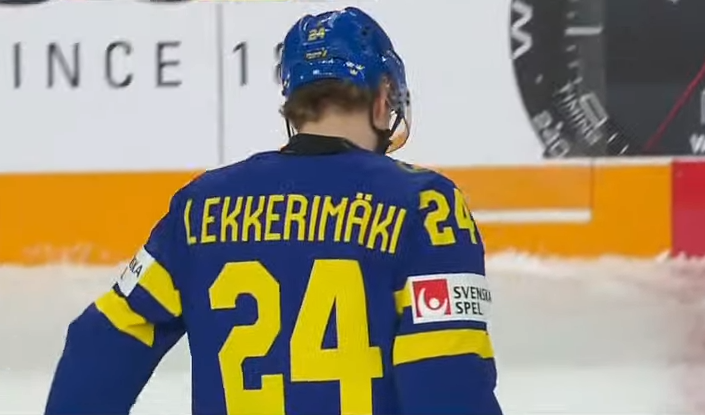Sweden had an easy time in their first game of the 2023 World Juniors, cruising past Austria by an 11-0 score.
Their second game, against Austria’s Bavarian neighbours, wasn’t so easy. Germany proved that they won’t be an easy out in this year’s World Juniors thanks to goaltender Nikita Quapp, a disciplined system, and some dangerous talent up front.
Sweden prevailed by a 1-0 score in a game far more thrilling than the single goal would suggest. It was a true goaltender’s duel. Quapp came up with 43 saves on 44 shots, but Carl Lindblom also needed to make some big stops in his 28-save shutout in the Swedish net.
Unlike against Austria, Canucks prospects Jonathan Lekkerimäki and Elias Pettersson didn’t figure into the scoring. The lone Swedish goal came with just 22 seconds left in the first period when an Adam Enstrom point shot pinballed off two German skaters before skittering past Quapp.
Limited ice time for Lekkerimäki
Lekkerimäki saw limited usage, particularly in the third period as Sweden defended their one-goal lead. He finished with just 11:42 in ice time, second-last among Swedish forwards, despite getting time on Sweden’s first power play unit.
In those limited minutes, Lekkerimäki managed two shots on goal. He didn’t play poorly, with some surprising tenacity on the forecheck. He still needs some work on his game off the puck, both in the offensive zone and the defensive zone.
In the offensive zone, he needs to be more active with his feet to find open ice to get open for his teammates. He has an excellent shot but needs to find space to use it more frequently. In the defensive zone, Lekkerimäki is passive, playing his position but not proactively taking away time and space.
When Lekkerimäki did get space to use his shot, he looked dangerous. He nearly had the game’s opening goal on a rising wrist shot after his linemate stole the puck in the offensive zone. Lekkerimäki’s shot ticked off the top of Quapp’s glove and went just high.
Lekkerimäki also created a dangerous chance for Sweden in the third period with a slick backdoor pass, but his linemate couldn’t finish.
While Lekkerimäki got plenty of ice time on the power play, it wasn’t particularly productive ice time. He seems very out of place in the bumper and had very few touches of the puck.
While it theoretically makes sense to have a shooter like Lekkerimäki in the bumper for quick one-timers, the Swedish power play doesn’t seem set up to create those opportunities. Lekkerimäki also rarely looks to tip the puck in the slot and doesn’t keep his stick on the ice available for slap-pass deflections.
The Swedish power play as a whole seemed directionless, particularly on a lengthy second-period 5-on-3 that failed to create a single good look. Lekkerimäki’s misuse in the middle is just one of many issues. He seems far better suited to playing on the left half wall, where he could use his shot more frequently.
Pettersson led Sweden in ice time
Pettersson played a major role for Sweden, leading the team with 20:45 in ice time. That’s in spite of spending four minutes in the penalty box for a pair of minor penalties.
Defending the lead in the third period, Swedish head coach Magnus Havelid repeatedly turned to Pettersson, as he played 9:21 in the third period alone. It’s a really good sign that Pettersson has earned such a big role already considering he was only expected to be a third-pairing defenceman heading into the tournament.
There was a lot to like about Pettersson’s game. He was physical, repeatedly taking the body along the boards in the defensive zone and stepping up to make hits in the neutral zone, though that got him in trouble on one interference penalty. Whenever he got the opportunity to staple an opponent into the boards, he did so.
Pettersson continued to show his smooth skating stride and mobility, covering a lot of ice and frequently jumping up in the rush and even on the forecheck, then swiftly getting back into position.
Pettersson is also an excellent passer, such as this superb backdoor feed that would have been a goal if not for a last-second stick check.
The two penalties weren’t ideal, as Germany looked dangerous on the power play, but Pettersson also drew a penalty and the Swedish penalty kill held up. With his physical style, Pettersson might have a tough time staying out of the box.
It wasn’t a perfect game for Pettersson — it rarely is for an 18-year-old defenceman at the World Juniors — and he had a couple of shaky moments when he had to cover the right side of the ice instead of his natural left side.
He struggled to contain Ryan del Monte on one rush, as he left too much space open on the right side, then del Monte was able to slip the puck under the triangle of Pettersson’s stick for a dangerous chance.
Being on the right side also forced Pettersson to play the puck more on the backhand, which doesn’t appear to be a strength.
Pettersson was a go-to penalty killer for Sweden, but also had some issues shorthanded, failing to clear the puck on an open opportunity during a dangerous German power play early in the third period. The first penalty killing unit ended up stuck on the ice for the entire two minutes.
He wasn’t the only penalty killer who failed to clear the puck, of course, but it wasn’t an ideal situation. Eventually, he was the one who cleared the puck at the very end of the power play.
It’s important to keep in mind that Pettersson is just 18 years old, as is Lekkerimäki. Both players have another year of World Junior eligibility left and one might expect some warts to show up in Pettersson's game when he's playing nearly 21 minutes, ahead of older defencemen.




